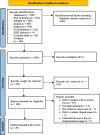An insight into the use of telemedicine technology for cancer patients during the Covid-19 pandemic: a scoping review
- PMID: 38641567
- PMCID: PMC11027268
- DOI: 10.1186/s12911-024-02507-1
An insight into the use of telemedicine technology for cancer patients during the Covid-19 pandemic: a scoping review
Abstract
Background: The use of telemedicine technology has significantly increased in recent years, particularly during the Covid-19 pandemic. This study aimed to investigate the use of telemedicine technology for cancer patients during the Covid-19 pandemic.
Methods: This was a scoping review conducted in 2023. Various databases including PubMed, Web of Science, Scopus, Cochrane Library, Ovid, IEEE Xplore, ProQuest, Embase, and Google Scholar search engine were searched. All quantitative, qualitative, and mixed-method studies published in English between 2020 and 2022 were included. Finally, the needed data were extracted, and the results were synthesized and reported narratively.
Results: A total of 29 articles were included in this review. The results showed that teleconsultation, televisit, and telerehabilitation were common telemedicine services, and video conferencing and telephone were common technologies used in these studies. In most cases, patients and healthcare providers preferred these services compared to the face-to-face consultations due to their convenience and advantages. Furthermore, the findings revealed that in terms of clinical outcomes, telemedicine could effectively reduce anxiety, pain, sleep disorders, and hospital admission rates.
Conclusion: The findings provided valuable insights into the various telemedicine technologies, services, users' perspectives, and clinical outcomes in cancer patients during the Covid-19 pandemic. Overall, the positive outcomes and users' satisfaction showed that the use of telemedicine technology can be expanded, particularly in cancer care. Future research needs to investigate both clinical and non-clinical effectiveness of using various telemedicine services and technologies for improving cancer care delivery, which can help to develop more successful strategies for implementing this technology.
Keywords: Cancer; Covid-19; Scoping review; Telemedicine.
© 2024. The Author(s).
Conflict of interest statement
The authors declare no competing interests.
Similar articles
-
Application of telemedicine technology for cardiovascular diseases management during the COVID-19 pandemic: a scoping review.Front Cardiovasc Med. 2024 Aug 12;11:1397566. doi: 10.3389/fcvm.2024.1397566. eCollection 2024. Front Cardiovasc Med. 2024. PMID: 39188320 Free PMC article.
-
Utilization of telehealth to manage the Covid-19 pandemic in low- and middle-income countries: a scoping review.J Am Med Inform Assoc. 2023 Mar 16;30(4):738-751. doi: 10.1093/jamia/ocac250. J Am Med Inform Assoc. 2023. PMID: 36565464 Free PMC article.
-
Beyond the black stump: rapid reviews of health research issues affecting regional, rural and remote Australia.Med J Aust. 2020 Dec;213 Suppl 11:S3-S32.e1. doi: 10.5694/mja2.50881. Med J Aust. 2020. PMID: 33314144
-
Overview of Technologies Implemented During the First Wave of the COVID-19 Pandemic: Scoping Review.J Med Internet Res. 2021 Sep 14;23(9):e29136. doi: 10.2196/29136. J Med Internet Res. 2021. PMID: 34406962 Free PMC article.
-
The Use of Telehealth Among People Living With Dementia-Caregiver Dyads During the COVID-19 Pandemic: Scoping Review.J Med Internet Res. 2023 May 25;25:e45045. doi: 10.2196/45045. J Med Internet Res. 2023. PMID: 37227755 Free PMC article.
Cited by
-
An overview of reviews on digital health interventions during COVID- 19 era: insights and lessons for future pandemics.Arch Public Health. 2025 May 9;83(1):129. doi: 10.1186/s13690-025-01590-8. Arch Public Health. 2025. PMID: 40346715 Free PMC article.
-
Virtual reality for cancer symptom management: a systematic review of randomized controlled trials.Support Care Cancer. 2025 Jul 9;33(8):672. doi: 10.1007/s00520-025-09738-6. Support Care Cancer. 2025. PMID: 40632238
References
-
- Albert T. Latest global cancer data: Cancer burden rises to 18.1 million new cases and 9.6 million cancer deaths. International Agency for Research on Cancer; 2018 Sep. p. 3.
Publication types
MeSH terms
Grants and funding
LinkOut - more resources
Full Text Sources
Medical


